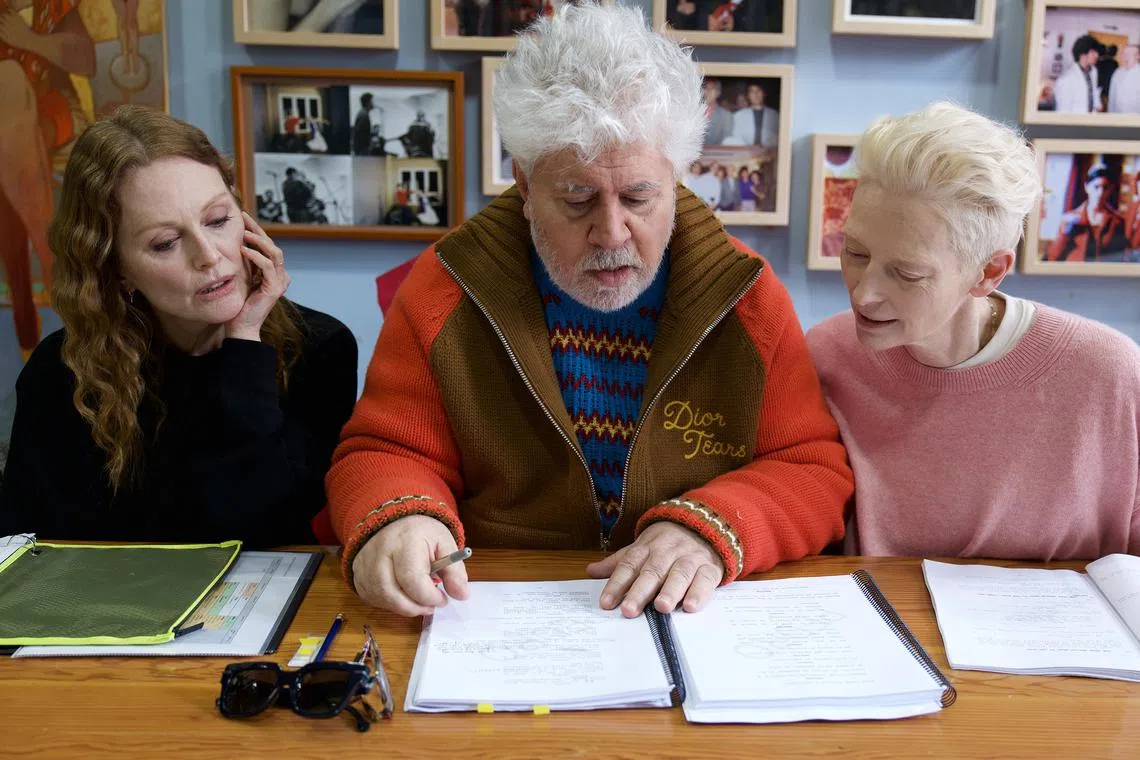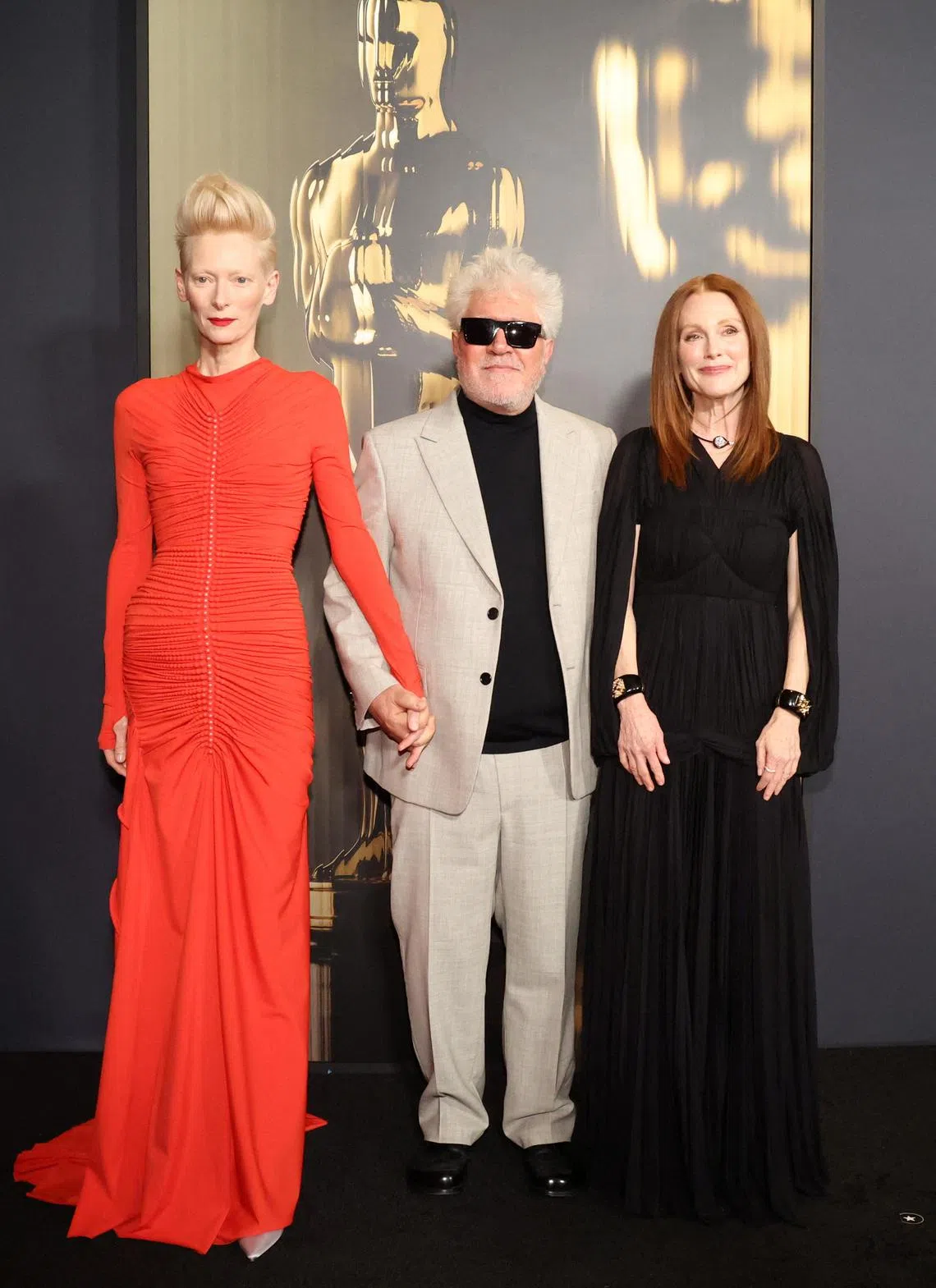When coming to America, European directors sometimes get lost in translation
Sign up now: Get ST's newsletters delivered to your inbox

Director Pedro Almodovar (centre) with actresses Julianne Moore (left) and Tilda Swinton on the set of The Room Next Door.
PHOTO: WBEI
Follow topic:
NEW YORK – When Pedro Almodovar’s The Room Next Door won the Golden Lion for best film at 2024’s Venice Film Festival, it was the first time that the Spanish director had garnered the top prize at one of Europe’s major film festivals.
What made this victory even more impressive and unusual was that The Room Next Door – a drama about female friendship starring American actress Julianne Moore and British actress Tilda Swinton – was Almodovar’s first full-length film in English.
For a leading auteur of contemporary cinema, and one whose work is so intertwined with the textures of his native tongue, Almodovar’s late-career shift to English-language film-making feels daring.
If the film’s reception at Venice is any indication, it appears that the gamble has paid off and he has succeeded where many others have failed.
Almodovar, 75, is only the latest in a long line of European directors to make the leap to English-language film-making. The history of such transitions is uneven, and ranges from the Golden Age of Hollywood classics of Austrian-born Billy Wilder to infamous missteps by Sweden’s Ingmar Bergman and France’s Francois Truffaut.
Hungarian film-maker Kornel Mundruczo said that working in English and directing Hollywood stars present European directors with a unique set of hurdles.
“It was a huge challenge to understand the cultural differences and not to create something which is symbolically, say, sinking into the Atlantic Ocean,” he said, recalling in a recent telephone interview the making of his English-language debut, Pieces Of A Woman (2020).
“There are so many movies like that,” added Mundruczo, who finished shooting At The Sea, his new film starring American actress Amy Adams, in Boston in August.
Hollywood was, in certain ways, a European invention. Many of the pioneers of American cinema were immigrants, fleeing repression or seeking opportunity in a new world. German, Austrian and Hungarian emigre directors, including Fritz Lang and Wilder, brought sharp chiaroscuro lighting, existential dread and savage wit to Hollywood, reshaping American cinema into something darker and more psychologically acute.

The Room Next Door was Almodovar’s first full-length film in English.
PHOTO: WARNER BROS
Post-war film history, however, is full of examples of foreign directors who have stumbled while scaling the peaks of Mount Hollywood. The English-language efforts of continental auteurs were frequently dismissed as European art films in American drag. They often left the impression of an artist struggling to translate his artistic vision and sensibility into a language he neither spoke fluently nor understood intuitively.
In his review of Truffaut’s Fahrenheit 451 (1966) for The New York Times, journalist Bosley Crowther wrote that the director “got himself tangled up” with “language he couldn’t fashion into lively and witty dialogue”.
Five years later, another American film critic, Vincent Canby, called the dialogue in Bergman’s English-language debut, The Touch (1971), reminiscent of “those early, grammatically perfect and lifeless translations of (Norwegian playwright Henrik) Ibsen”.
There have been notable exceptions, including Italy’s Michelangelo Antonioni in Blow-Up (1966) and Germany’s Wim Wenders, who won the Palme d’Or top prize at the Cannes Film Festival for the English-language Paris, Texas (1984).
Then there are films that were largely derided or ignored upon their release, but that have since undergone a critical re-evaluation, such as Italian director Federico Fellini’s Casanova (1976) or Antonioni’s The Passenger (1975).
For some, making films in America and in English has been as much about survival as it has been about art. During the Cold War, Roman Polanski and Milos Forman left Eastern Europe for the West, escaping repression and censorship in Poland and what was then Czechoslovakia respectively.
“Milos Forman was, for me, a role model when it came to stepping over to the English language,” Swedish film-maker Ruben Ostlund said in a recent telephone interview.

Tilda Swinton, Pedro Almodovar and Julianne Moore attend the Academy of Motion Picture Arts and Sciences 15th Governors Awards at the Ray Dolby Ballroom in Los Angeles, on Nov 17.
PHOTO: REUTERS
Two of Forman’s American films, One Flew Over The Cuckoo’s Nest (1975) and Amadeus (1984), took home Oscars for best picture and best director, a sign of the Czech-born film-maker’s mastery in making films in his adopted language.
Ostlund’s two most recent films, The Square (2017) and 2022’s Triangle Of Sadness (his first film entirely in English), both won the Palme d’Or. The director called his own turn to English-language film-making “a very organic development”.
Like Ostlund, Mundruczo has found creative opportunities in working in English, including greater visibility, but making movies on the other side of the Atlantic has also been an artistic necessity for him.
In recent years, many have warned that artistic freedom in Hungary is under threat. Mundruczo said he has not been able to secure major funding for a project in his home country since 2017. “I definitely want to do Hungarian movies, and it feels just impossible right now,” he said.
For Almodovar, the turn to English-language film-making is neither a response to artistic repression at home nor the dream of a director who knows that films in his native tongue will have limited appeal. Unlike Swedish or Hungarian, Spanish is one of the most widely spoken languages around the world.
“English is an interesting language for Almodovar because English is the language of punk and rock,” scholar Ana Maria Sanchez-Arce, author of The Cinema Of Pedro Almodovar, said in a telephone interview.
“And I think that he’s got to a point where he can make this film the way he wants to make it,” she added, noting that The Room Next Door features many of the director’s usual collaborators, who help give his films their distinctive texture.
According to Dr Ernesto R. Acevedo-Munoz, who has written a monograph for the British Film Institute on Almodovar, the director’s eye-popping visual style and how he uses and plays with genre conventions have long been key to his success internationally.
“Almodovar found a very idiosyncratic but well-defined spectrum of melodrama where he works in terms of mise-en-scene, and topics like death and motherhood and loss and grief,” said Dr Acevedo-Munoz, a professor of cinema studies at the University of Colorado.
“The language of the cinema, especially when it comes to genre, is universal. And I think that’s where Almodovar can say, ‘Okay, I’m going to make this movie, but I’ll work still within my own aesthetic,’” he said. “And his aesthetic has become increasingly visual in a way that transcends national specifics. Or even language.” NYTIMES
The Room Next Door is showing in Singapore cinemas.

